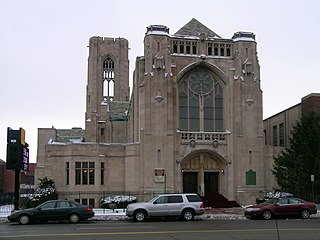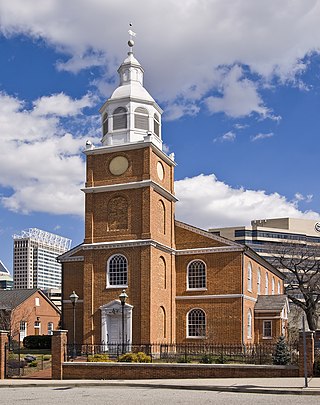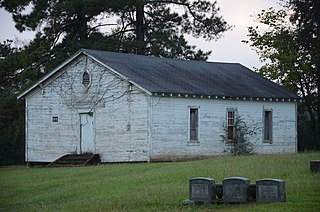
Red Rock Center for the Arts is a historic structure located at 222 East Blue Earth Avenue, in Fairmont, Minnesota, United States. It was added to the National Register of Historic Places on May 18, 1988 as the First Church of Christ, Scientist. It is now owned by Martin County, which leases it to the Martin County Preservation Association.

The former First Church of Christ, Scientist, built in 1939, is an historic Classical revival style Christian Science church edifice located at 501 Riverside Drive, overlooking the Truckee River in Reno, Nevada. Anna Frandsen Loomis, a wealthy local Christian Scientist, underwrote the $120,000 cost of the building, including land acquisition and architect's fees. She was responsible for hiring noted Los Angeles architect Paul Revere Williams, the first African-American member of the AIA. In 1998 the congregation sold the building and used the funds from the sale to construct a new church at 795 West Peckham Lane. Church member and local theater patron Moya Lear donated $1.1 million to the Reno-Sparks Theater Community Coalition, which used the funding to purchase the First Church of Christ, Scientist and renamed it the Lear Theater.

The Central Woodward Christian Church, now known as Historic Little Rock Missionary Baptist Church, is a Gothic Revival church located in Detroit, Michigan. It was listed on the National Register of Historic Places in 1993.

The Lackawanna County Children's Library is located in Scranton, Lackawanna County, Pennsylvania, at 520 Vine Street. Built in 1915 as a church, the building is known for its Classical Revival architecture.

Roosevelt Community Church, formerly First Church of Christ, Scientist, Phoenix, is an historic church building located at 924 North First Street, in Phoenix, Arizona. On August 10, 1993, it was added to the National Register of Historic Places. The previous First Church congregation now holds services at 830 North Central Avenue.

First Church of Christ, Scientist, built in 1907, is an historic Christian Science church building located at 406-408 Middle Street, in New Bern, Craven County, North Carolina, in the United States. It was designed in the Classical Revival style by prolific local architect Herbert Woodley Simpson.

First Church of Christ, Scientist, built in 1901, is an historic Mission Revival-style Christian Science church located at 3606 Lemon Street in Riverside, California. It has been called: "the church that introduced Christian Science to Southern California." It was designed by noted Los Angeles architect Arthur Burnett Benton. On September 22, 1992, First Church of Christ, Scientist, was added to the National Register of Historic Places. It is still listed in the Christian Science Journal as an active Christian Science church.

Otterbein Church, now known as Old Otterbein United Methodist Church, is a historic United Brethren church located in Baltimore, Maryland, United States. The first "German Reformed" church was built to serve the German Reformed and some Evangelical Lutheran immigrants, and later entered the Brethren strain of German Reformed Protestantism in the later Church of the United Brethren in Christ.

The former First Church of Christ Scientist, is an historic Christian Science church building located at 315 Wisconsin Avenue, Madison, Wisconsin, United States. Built in 1929, it was designed in the Classical Revival-style by noted Madison architect Frank M. Riley. In 1982 the building was added to the National Register of Historic Places.

The former First Church of Christ, Scientist, is an historic Christian Science church building located at 700 22nd Street, Rock Island, Illinois, United States. Designed by architect William C. Jones of Chicago in the Palladian style, it was built between 1914-1915. Its exterior walls are of brick covered by Bedford limestone. Its superimposed front portico is supported by six 2 story columns with egg-and-dart capitals. Its dome actually consists of 2 domes: an outer dome and an inner dome which are separated by a space for lighting fixtures and maintenance. The inner dome consists of some 8,000 colored fish scale glass panes on a wooden support structure. The inner dome is similar to the inner dome of First Church of Christ, Scientist in Kalamazoo, Michigan, which was designed by William C. Jones in 1913.

The United Church of Christ in the Philippines is a Christian denomination in the Philippines. Established in its present form in Malate, Manila, it resulted from the merger of the Evangelical Church of the Philippines, the Philippine Methodist Church, the Disciples of Christ, the United Evangelical Church and several independent congregations.

St. Paul's United Church of Christ of Laramie was founded in 1886 as the first German language congregation in Wyoming. The church building was listed on the National Register of Historic Places in 1983. The cornerstone was laid on July 13, 1890, three days after statehood. Clergy from Chicago and the local Christian, Methodist, Episcopal, Presbyterian and Baptist Churches participated in the ceremony, with an address by Dr. John Wesley Hoyt, former Governor of Wyoming Territory and at the time first president of the University of Wyoming. The building was completed and dedicated on January 18, 1891. It is the oldest church structure in Laramie continuously used by the same congregation. With its stained glass windows and heavy wooden furnishings, St. Paul's is reminiscent of rural German churches. Those elaborate windows and its many simplified Gothic elements make the building unique among Lutheran churches in Wyoming.

The First Presbyterian Church is a historic church in Little Rock, Arkansas. It was designed by architect John Parks Almand and was built in 1921. It is a high quality local interpretation of the Gothic Revival style. It was listed on the National Register of Historic Places in 1986.

John Parks Almand was an American architect who practiced in Arkansas from 1912 to 1962. Among other works, he designed the Art Deco Hot Springs Medical Arts Building, which was the tallest building in Arkansas from 1930 to 1958. Several of his works, including the Medical Arts Building and Little Rock Central High School, are listed on the National Register of Historic Places.

The First United Methodist Church is a historic church building in Fordyce, Arkansas. The two story brick building was designed by John Parks Almand and built in 1925. The Arts and Crafts style building presents a long facade to East 4th Street, with its main entry separating the sanctuary to the right and a wing of offices and Sunday School classrooms to the left. It was the second church for a congregation established c. 1883; the first was destroyed by fire in 1922.

Moscow Methodist Church and Cemetery is a historic landmark built in 1864 and added to the National Register in 2006. The former community of Moscow is located just outside the current city limits of Prescott, Arkansas. The area is on or near the old "Moscow-Camden Road", or "Wire Road" which ran between Moscow and Camden, Arkansas. As of 2016, the location was known as the junction of Nevada County Roads 23 and 260.

All Souls Church is a historic church built in 1906, located on Arkansas Highway 161, and United States Route 165 in Scott, Arkansas.

The former First Church of Christ, Scientist, also known as The City Church, is located in Cedar Rapids, Iowa, United States. Christian Science began in Boston in 1866 and it was introduced to Cedar Rapids twenty years later. A Sunday School was established in 1887 and it met at the old Dows Auditorium at Third Avenue and Third Street SE. The congregation was established in 1891 as an official branch of The First Church of Christ, Scientist in Boston. It was the first Christian Science congregation established in Iowa. They held their Wednesday evening services at the Peoples Unitarian Universalist Church. The congregation began construction on this building in 1914 and it was dedicated on Easter Sunday the following year. It is a red brick structure in the Neoclassical style. The rectangular building features a portico with four columns in the Doric order on the main facade, and a centered raised gable roof with cornice returns. The architectural style was chosen to "attract non-churchgoing people that may be intimidated by traditional religious structures." The congregation has subsequently moved to a new facility on Blairs Ferry Road, NE. This building was listed on the National Register of Historic Places in 2017.




















